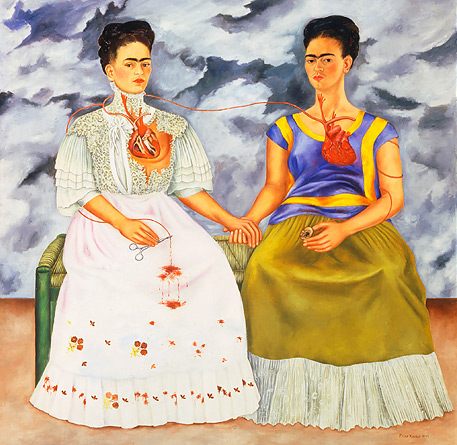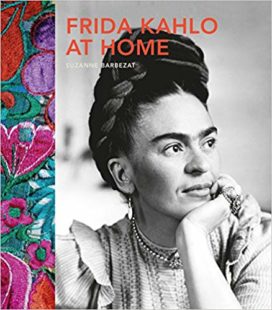
An artist who epitomizes an individual’s triumphant spirit to overcome challenges through creativity is Frida Kahlo, July 6, 1907 – July 13, 1954. One of the most respected women artists her art has been praised for its originality and its surreal, dreamlike, and fantastical quality.
At the age of six Kahlo was stricken with polio. At age 18 she was in a bus when it overturned. She suffered numerous injuries including a broken spinal column, a broken collarbone, and 11 fractures in her right leg. Throughout her life the woman had relapses of tremendous pain and fatigue, which caused her to be hospitalized for long periods of time. She had to undergo more than 30 operations in her lifetime. Despite the medical treatment she had received in San Francisco, Kahlo’s health problems continued throughout the 1940s. Due to her spinal problems, she wore 28 separate supportive corsets, varying from steel and leather to plaster, between 1940 and 1954. She experienced pain in her legs, the infection on her hand had become chronic, and she was also treated for syphilis.
Frida Kahlo taught herself to paint during her initial recuperation period. Through her art she reflected and transcended her suffering and loss. In her highly personalized style she exposed intimate aspects of herself. Her paintings were a type of catharsis, releasing sorrow and pain associated with her physical trauma.

In many of her self-portraits Kahlo is surrounded by symbols that represent superstitions and folklore. The surrealist usage of mask and costume is part of everyday rituals in Mexico, and death in the realm of the sacred, also worked as a resource to address the matter of identity and gender. In some of her self-portraits, Frida Kahlo painted herself wearing ornaments and accessories that identify with the pre-Hispanic past and the indigenous cultures of Mexico. These paintings evoke powerful women such as goddesses or tehuanas, appropriating the identities of these Amazon matriarchs.

In the book Frida Kahlo At Home (available on Amazon.com) author Suzanne Barbezat states, “As a teen and young adult, Frida experimented with different styles of dress. She was clearly aware of the power of clothing in crafting her identity, and enjoyed making a statement and even shocking people with her different looks.”
In 1931 Kahlo had a miscarriage — a huge traumatic loss for her. As explained in Barbezat’s book, Kahlo asked the doctors to show her the fetus or lend her a medical textbook so she could picture its stage of development. Although the doctors refused her wish to see the fetus, she was able to research images in books which she later depicted in her work.
Kahlo also explored her sexual and cultural identities such as childbirth and abortion. As Barbezat remarks in her book “Frida broke taboos by depicting the harsh, raw reality of her private experiences in her art. The images of a woman in the act of giving birth, with legs spread wide and blood on the sheets, is chocking even now, but in the 1930’s must have been exponentially more so.”
Kahlo wrote, “I paint self-portraits, because I paint my own reality. I paint what I need to. Painting completed my life. I lost three children and painting substituted for all of this.” She wrote in her diary, “I am not sick, I am broken. But I am happy to be alive as long as I can paint.”
As many artists have done, instead of hiding her disability and traumas shamefully, Kahlo used her art as a way to bare her pain and tragedy. Through her many self-portraits she was able to project her pain onto the canvas. This enabled her to relieve herself from the burden of dealing with her agony.
Read articles written by living artists who have overcome tragedy, pain and loss through art in our series of “Artists Stories”.

hi i am currently doing a research about frida and brought me to this one.it is a very informative article and i just want to know when was this article published.response is very much appreciated.thank you
Dear Ziggy, The estimated publication date is sometime in August, 2019. I We wish you success with your research project.
Frida has always been one of my creative and artistic heroes. Her ability to use art to transcend her physical and mental imprisonment is a testament to the healing power of art. As someone who also found their way back to art to process my own pain and trauma, I feel a deep connection to artists who see art as a road to liberation.
I am so happy to have come across your community and site through my own research. It fills me with joy to find like minded people striving to bring art to the forefront of mental and emotional well being.
Thank you for this article and the phenomenal work you are doing!
Hi Shelia, We’re delighted to now that your research led you to us! Welcome. And, I’m happy to know you enjoyed the article about Frida Kahlo.
Hi, I am a psychologist who have used the art of Frida Khalo with Latina women in a group format, and in 2005 an article was written in the New York Times about this innovative modality. Presently I work with ptients experiencing Physical pain due to accidents. I am in the process of following up via writing about it or other means. This writing was most interesting.
I found Frida Kahlo’s work 20 years ago, during a turning point in my life, when I was ready to pursue art more intensely. The emotional depth of her art spoke to me, and inspired me to express myself and have more courage doing so. I can’t imagine any woman artist not resonating with her work! Thank you Renee for your article on this amazing woman.
I agree with you Lisa. Few artists compare to Frida. Thank you for reading this article about her.
Hello,
I like to read your article about Frida Kahlo, because I like her and had painted her. Thank you.
I am an female artist at Germany and now beginning to make my art as a profession. Before I had studied ART and German and had worked as teacher for ART and German at School for 16 years . Since some years I had several exhibitions around the area of Nuremberg, then at the Greek isle of Patmos, at Metanoia Galerie, Paris, Eufemia Galleria in Venice, townhall of Cadolzburg until 18.6.18. At the moment I am showing 14 pictures at “Atelier Eins”, Germany at the Exhibition “Sommerträume” until 26.07.18 at the City of Nuremberg. My themes are emotions of persons, landscapes, houses and objects. Technics: Acryl, water-Colour, oil- pastells, softpastells, pencils on paper and canvas. I would enjoy to meet or contact you.
Dear Regina, Thank you for visiting our website. Please become a subscriber and receive our free weekly email newsletter. I wish you tremendous joy and success in your art career. You may want to consider submitting artwork to one of our online art exhibitions. Best regards, Renee Phillips
I simply want to mention I am beginner to blogging and certainly enjoyed your page. Almost certainly I’m likely to bookmark your blog post . You certainly have excellent writings. Thank you for sharing with us your website.